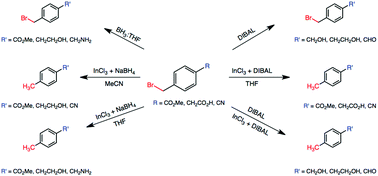Binary reducing agents containing dichloroindium hydride for the selective, partial, or tandem reductions of bifunctional compounds consisting of halo-nitriles, halo-esters and halo-carboxylic acids†‡
Abstract
The selective, partial, or tandem reductions of bifunctional compounds containing primary alkyl or benzyl bromides can generate a variety of different products using a mixture of dichloroindium hydride (HInCl2) and an additional hydride, such as borane–tetrahydrofuran (BH3 : THF) or diisobutylaluminum hydride (DIBAL-H). Binary metal hydride systems, containing HInCl2 and BH3 : THF, are readily generated from anhydrous indium trichloride (InCl3) and sodium borohydride (NaBH4) in THF. Dichloroindium hydride can reduce primary halides and in the presence of another hydride, either generated in situ or added to the single-pot reaction, can perform tandem reductions of a variety of bifunctional bromides. Together, the hydrides reduce carbon–halogen bonds as well as an electrophilic group, such as a nitrile, an ester, or a carboxylic acid. The reduction of 4-(bromomethyl)benzonitrile using the HInCl2 and BH3 : THF binary metal hydride system affords 4-methylbenzylamine in an excellent yield under ambient conditions and short reaction times. By using the binary metal hydride system consisting of HInCl2 and DIBAL-H, the tandem reduction of 4-(bromomethyl)benzonitrile was achieved affording para-tolualdehyde in an excellent yield, also under ambient conditions. The reduction of 4-(bromomethyl)phenyl acetic acid by HInCl2 selectively reduced the carbon–halogen bond generating para-tolylacetic acid. When using either of the binary hydride systems, both functional groups were reduced generating 4-methylphenethyl alcohol. Methyl 4-(bromomethyl) benzoate underwent a selective or tandem reduction to generate [4-(bromomethyl)phenyl]methanol, methyl 4-methyl benzoate or para-tolylmethanol depending on the hydride system used. Consequently, a single bifunctional compound was transformed into a variety of different compounds by the simple manipulation of the binary hydride system used without the need for protecting groups, and in most cases, by a one-pot procedure.

- This article is part of the themed collection: Celebrating the 80th Birthday of Professor Ei-ichi Negishi

 Please wait while we load your content...
Please wait while we load your content...